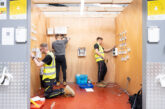
Leading sustainability authority, Bureau Veritas, has stated that while various worldwide governments setting dates to target the ban of petrol and diesel vehicle sounds optimistic, there is a significant lack of a bigger picture around the wider environmental impact that comes with the roll-out of ZEVs (zero emission vehicles), and the capabilities of the network evolving quickly to meet demand.
It comes as world leaders united on ‘Transport Day’ (November 10) to discuss the roll-out of ZEVs, net-zero shipping routes and a sustainable aviation sector. The significant pledge to come out of the discussions as the end of COP26 nears include more than 30 countries and six major vehicle manufacturers committing to 100% zero emission car sales by 2040 or earlier. In the UK, the target is 2030.
According to Richard Maggs, Head of Environment & Sustainability at Bureau Veritas, the climate pledges made yesterday significantly lack in detail and big picture thinking. He said: “Yesterday’s COP26 discussions had a strong focus on vehicles themselves having zero-emissions and reducing tailpipe gases. However, there continues to be a lot of tunnel vision around the wider impact on the supply chain and with over 30 countries agreeing to ban the sale of petrol and diesel cars in the next couple of decades, the rush to roll out ZEVs is now well and truly on.
“To achieve a true circular economy in the line with the Government’s 2050 net zero target, more must be done to improve the environmental impact of the whole lifecycle of car production. As EVs become more commonplace around the globe, the demand for lithium (for example) will drastically increase – an issue made more difficult by the fact that just nine countries are currently major producers of the metal. Therefore, consideration must be had around the sustainable transportation and distribution of the product globally, to ensure the entire lifecycle of ZEVs will improve carbon emissions and air quality.”
The circular economy considers emissions across the entire supply chain, from procurement to disposal. It also considers improving the social sustainability of practices, including ethics and societal impact of these changes.
“On the other end of the lifecycle of an electric vehicle, processes must be put in place to ensure sustainable practices around re-using or recycling batteries, as products like this cannot simply go into landfill. This can be done by utilising batteries in battery storage systems for renewable energy,” Richard concludes.
Utilising battery storage systems not only provides a sustainable practice for re-using vehicle batteries, but also supports the Grid in the supply of power – especially as the use of electric is increasing not only in vehicles, but in heating systems too as gas is phased out.
Michael Kenyon, Head of Electrical Technical Development MIET at Bureau Veritas, said: “Battery storage systems are an excellent way to combat energy usage, as they can store up energy collected when renewable sources are plentiful. Using battery storage means the home and workplace are ‘prosumers’ – both producers and consumers of energy – which will ultimately help the grid cope with the increasing demands of a society on the road to net zero.”
Michael also highlights that there must be a focus on installing smart systems to support the increased demand on the grid, to ensure it is not overloaded by the increased use of electric in the home and workplace.
He said: “It is clear the Government has a sharp focus on ZEVs and meeting its 2030 target, however there is still a long way to go to ensuring that a network of charge points can meet the ever-increasing demand. Many large housing developments and commercial buildings were not built with a net zero future in mind, and therefore will require smart technologies and local renewables to be installed to cope with not only the mass charging of electric vehicles but continuing to meet the demands normal life, especially as new technologies are introduced to replace gas heating systems. This could include systems in place to phase electric car charging amongst neighbours, or utilising power overnight to charge vehicles, whilst electric is not being used elsewhere in the home. The charge in the EVs could also be used to supplement the grid and smooth the increased demand at peak times.”
A recent survey by the Competition and Markets Authority (CMA) concluded that the UK will need more than ten times the current 25,000 existing charging points to meet the demands of the Government’s 2030 ban on fossil fuel powered cars1. Michael states that while there is a big job still to be done, charge points operators (CPOs) must ensure correct installation and maintenance of charge points and accessibility, so that ‘quick’ does not take priority over ‘quality’, resulting in greater risk to the users and business reputation.
“CPOs are now facing the twin challenge of adopting evolving innovative technological solutions for drivers, while providing 99% availability and reliability of their network as the demand for charge points ever increases. This can only be achieved if they take steps now to follow best practice when it comes to installation, functionality and regular maintenance of their assets – starting with a robust strategy and impartial certification.
“At Bureau Veritas. we work with charge point operators in several different sectors, and we’ve found that some of the key areas for consideration include cybersecurity risk, grid code compliance as well as repairs and components management. With more and more EV charge points popping up, duty holders should be ensuring compliant installation, periodically inspecting their EV charge points at least annually with Residual Current Devices tested every 6 months as part of the business’s Health and Safety Risk Management obligations. This is critical to maintaining the long-term integrity and availability of this vital charging infrastructure.”
To find out more about Bureau Veritas’ EV charge point testing and inspection services click here








